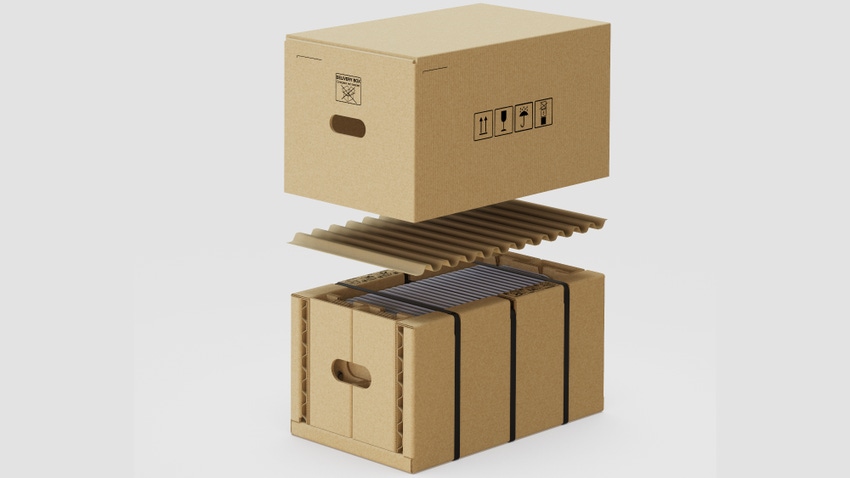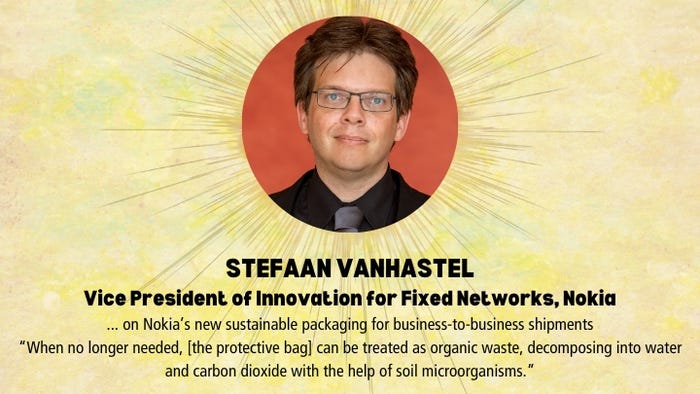Nokia Dials in Packaging Circularity
The tech giant is moving to 100% recyclable B2B shipment packaging for its Lightspan portfolio of broadband access nodes by the end of 2023.

As companies work to improve their packaging sustainability, circularity — recyclable, reusable — is often where they put their efforts now. While many of the eco-advancements happen in the public eye with consumer products, the business-to-business (B2B) supply chain offers another area of significant contribution.
Here’s a great example: the latest packaging redesign by Nokia for its Fixed Networks Lightspan portfolio for its customer Deutsche Telekom.
Nokia’s new compact packaging reduces packaging waste by being 60% smaller than the previous pack, and 44% lighter. This reduces the line’s CO2 emissions by up to 60%, according to the company.
Additionally, the new packaging:
• Eliminates non-biodegradable foam, plastic, bleaching, toxic materials, and chemical treatments.
• Replaces protective plastic covers with a biodegradable version.
• Uses recyclable corrugated cushioning, compliant with the Forest Stewardship Council, to protect the product from damage due to impact drops.
• Is designed for reuse in return shipments.
Stefaan Vanhastel, Vice President of Innovation for Fixed Networks at Nokia, gives us exclusive details:
How did Nokia reduce pack size by 60%? Is that how it reduced weight by 44%, by eliminating the size of the package?
Vanhastel: Yes, we are making product packages smaller without compromising protection during bulk transport. By using lighter materials like cardboard/paper instead of EPE (expanded polyethylene) foams, we aim to reduce the overall package weight. The improvements will vary for each product.
The new packaging eliminates non-biodegradable foam, plastic, bleaching, toxic materials, and chemical treatments. What are you using now?
Vanhastel: The elements may vary for each product.
• Home devices usually had white packaging. We use non-bleached cardboard to avoid chemical treatments.
• In the past, shock buffers for network products were made of EPE foam. We use alternatives like paper, organic*, or cardboard-based buffers for each product.
• Plastic bags, used to prevent scratches, are now replaced with biodegradable+ bags.
*What do you mean by organic? Can you give us an example?
Vanhastel: Sugar cane fibers represent one example of organic material.

+What biodegradable material is the protective cover made of now?
Vanhastel: Our current solution is a polyester made from natural compounds like lactide (LA), glycolide (GL), and ε-caprolactone (CL). We’re also exploring other materials with our suppliers. When no longer needed, it can be treated as organic waste, decomposing into water and carbon dioxide with the help of soil microorganisms.
The new packaging enables Nokia to ship more products per pallet. How many more?
Vanhastel: For one of our flagship products — FWLT-C, our Quillion based Multi-PON line card — we increased the pallet capacity from 52 pieces to 84 pieces.
How is the packaging designed for reuse in return shipments? Is the return packaging different from the original packaging? If so, how?
Vanhastel: Most of the packaging is usually discarded after opening. However, we designed our packaging so that after it’s opened, you could still re-use it for returns. Our design allows for multiple open and close actions that will not damage the package, allowing it to properly close and be used for returns if needed.
About the Author(s)
You May Also Like




